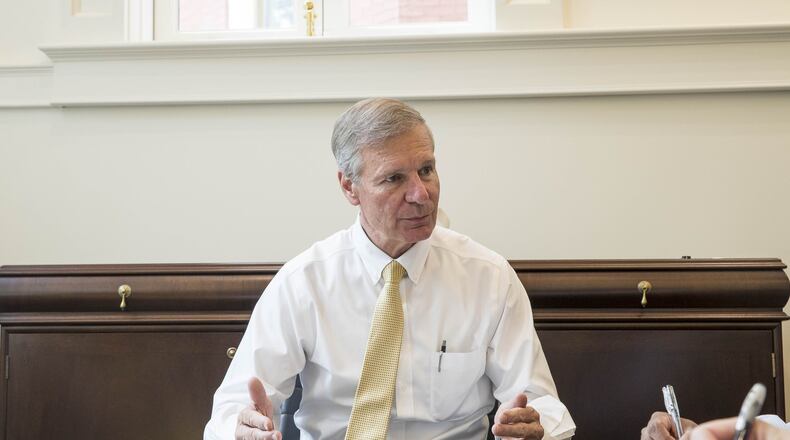In his role as president emeritus at Georgia Tech, G.P. “Bud” Peterson no longer has to worry about conference realignment and compensation for college athletes or the institute’s response to either issue.
He led the school through the most recent phase of major realignment, in 2011, and played a hand in keeping the ACC together. Now teaching and conducting research at Tech as a mechanical engineering professor after retiring from the presidency in 2019, he is fine to have his successor, Angel Cabrera, gauge Tech’s place in this summer’s realignment turbulence. Peterson joked that “the problems facing intercollegiate athletics today make thermodynamics seem easy.”
Nevertheless, Peterson has been an interested and informed observer, having also served as the chair of the NCAA’s board of governors from 2016-19, and has watched with dismay as USC and UCLA’s move to the Big Ten appear to be precursors to more dramatic shifts capable of altering college athletics.
To Peterson, the moves have been spurred by the increasing financial costs that athletic departments face. He said that, after the NCAA’s decision to grant athletes the right to be compensated for the use of their name, image and likeness, the conference shifts – namely, the recent moves of USC and UCLA to the Big Ten – and potential for super conferences have been unsurprising.
“Once the decision on NIL was made, the whole landscape for intercollegiate athletics changed,” Peterson said in an interview with The Atlanta Journal-Constitution. “It essentially became a free-for-all, and it’s totally being driven by money. I mean, completely driven by money.”
It could be argued that the free-for-all began well before the institution of the NIL rules in July of last year, and that the impact of NIL on revenues for athletic departments may be marginal. But it is part of a shifting tide in the realm of college athletes being able to be compensated beyond the value of a full scholarship. Along with expenses such as athletes receiving cost-of-living stipends and academic bonuses – changes in NCAA legislation that have been applauded – Peterson believes the additions to the budget will strain athletic departments and potentially lead to schools reducing support for non-revenue sports or cutting them altogether.
Stanford arguably is the most prominent school to have cut sports since the COVID-19 pandemic, citing costs, although it reversed its decision in the face of two lawsuits. During his tenure as president at Tech, Peterson was well aware of the financial constraints that the athletic department faced (and continues to face). Such predicaments might explain why UCLA, which according to a Los Angeles Times report ran a three-year deficit of $102.8 million through the 2021 fiscal year, would jump to the Big Ten and its TV riches and why others reportedly want to follow.
“There’s a lot of revenues coming to the institutions, but the number of institutions that operate their athletic departments in the black is about the number that make money on intellectual property,” said Peterson before offering a helpful clarifier. “It’s not very many.”
Should college sports move to a model where football breaks away from the NCAA and operates under its own umbrella, a widely predicted step, that could well lead to football players being paid. While the change easily could be justified given the revenues that those players bring in, the costs would mount higher and could open at least one more door of expenses that would, again, lead colleges to seek the most financially advantageous situations.
“I think it’s inevitable that, if we’re going down this path with football, basketball players aren’t going to say, ‘Oh, yeah, it’s OK for those football players to make $100,000 a year while they play their sport while we continue with our full-tuition scholarships,’” Peterson said. “That’s just probably unlikely.”
Peterson acknowledged that the money being directed to athletes hardly is the only source of the increasing costs. Coaching salaries obviously have risen dramatically, and athletic departments employ far more people than they once did.
“I really believe that coaches’ salaries is one of the things that drove the NIL issue because when the coaches were making what the faculty made, nobody was complaining that the universities were getting rich,” Peterson said. “But when the coaches are making $10 million and the players are getting nothing, how do you justify that?”
And beyond the spiraling costs, Peterson lamented realignment causing the breakup of conference rivalries and the impact that the increased travel will have on athletes.
“Not to pick on UCLA, but we’re going to have swimmers and tennis players travel across the country to East Lansing, Mich., to compete in the conference,” he said.
As for Peterson’s perspective on the net value of the changes?
“The money has resulted in a lot of changes,” Peterson said. “And some people think they’re changes for the better, some people think they’re changes for the worse. But I think everyone would agree that it has moved intercollegiate athletics far away from the initial purposes of universities sponsoring athletic teams.”
During his time on the NCAA board, Peterson said that he and colleagues recognized the impact that NIL could have, although perhaps not booster-led initiatives like collectives, whose intent is more to ensure that their teams’ athletes are compensated than to make use of their NIL value. Perhaps the most notable has been the deal that each scholarship offensive lineman at Texas has been offered, receiving $50,000 to do charity work and bring attention to those causes.
“They’re working within the guidelines that were provided, but those guidelines have allowed a lot more flexibility and a lot of things to happen that I don’t think have been particularly positive for intercollegiate athletics,” Peterson said.
The problem, he said, was developing effective rules.
“I’ve heard some people say that, ‘This is a solution, I have the solution,’ and you can sit and poke 1 million holes in it,” Peterson said. “This is a very, very difficult problem.”
That said, Peterson said the NCAA could have done more to devise guardrails as it prepared for the changes to NIL legislation. It was years in coming, spurred by the NCAA’s 2015 court defeat in a class-action lawsuit led by former UCLA basketball player Ed O’Bannon in a case revolving around football and men’s basketball players not being compensated for their NIL in video games and television broadcasts. The NCAA voted in October 2019 – two months after Peterson’s term as chair of the board of governors ended – to allow athletes to profit off their NIL.
The NCAA “probably could have done more to try to figure out how to deal with this situation once the legal case was settled,” Peterson said. “I think, to some extent, people thought the legal decision might go the other way, which might have made it easier.”
Peterson said that “maybe I bear some of the responsibility. I’m sure I probably do.”
One suggestion Peterson offered in regard to NIL compensation was that it be used as an incentive toward academic success and progress toward graduation.
“These are, after all, student-athletes,” Peterson said.
Peterson’s tenure as the chair of the NCAA board did produce multiple initiatives that have enhanced the welfare of college athletes. Perhaps the most significant was the introduction of legislation that better protected athletes’ time away from team activities. Another was legislation passed by the power-five conferences guaranteeing access for athletes to mental-health services. They are not, however, attention-getting matters like conference realignment.
“The NCAA gets beat up a lot, but there’s 1,100 institutions in the NCAA and 450,000 student-athletes,” Peterson said. “For 1,000 of those 1,100 institutions and for, I’ll say, 440,000 athletes, the NCAA works really well.”
About the Author
Keep Reading
The Latest
Featured


